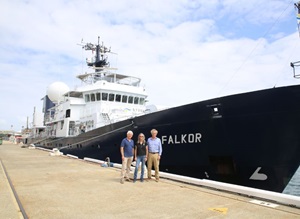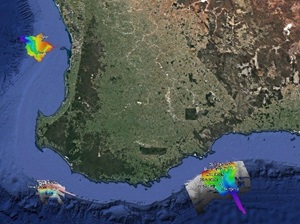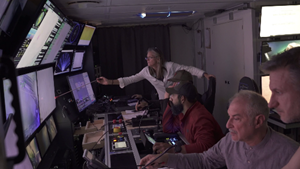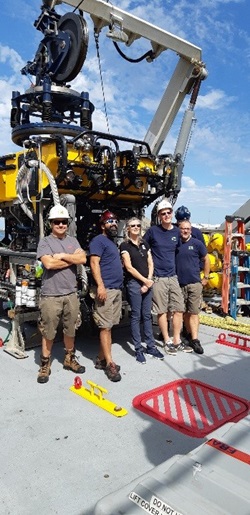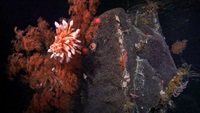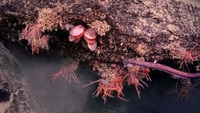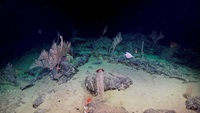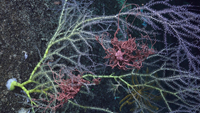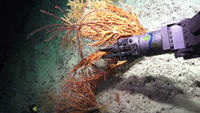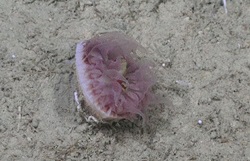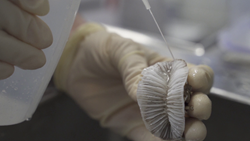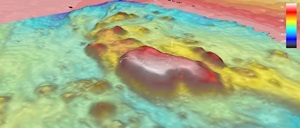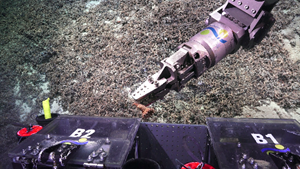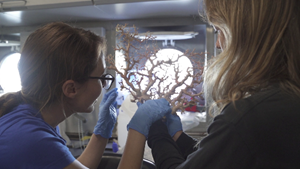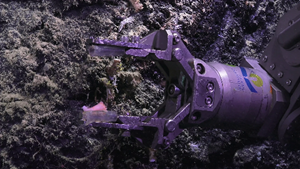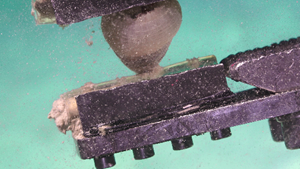PROJECT
The Ocean Institute’s Great Australian Deep-Sea Coral and Canyon Adventure
Research Highlight
Remarkable deep-sea expedition to previously unexplored deep sea canyons off our coastline seeks to unlock response to changes in the global ocean-climate system
|
As the majority of us packed up our offices or work stations for Christmas 2019, looking forward to some rest and relaxation, the Oceans Institute’s Dr Julie Trotter was knee deep in one of the busiest times of her life. A geochemist and ARC Future Fellow from The University of Western Australia, Dr Trotter was preparing to lead a team of international scientists on a month-long expedition to explore the unchartered depths of the Bremer, Leeuwin, and Perth submarine canyons located off the south west coast of Western Australia. Home for the next four weeks was to be the 83-metre-long oceanographic research vessel Falkor, a former German fishery protection vessel refitted and transformed to a state-of-the-art floating science lab by the philanthropic Schmidt Ocean Institute (SOI). Their mission? To unlock a window into our recent and geological past by surveying and sampling these deep-water canyon habitats, starting with Bremer, which sits along the shelf-edge off south western Australia, an area facing the Southern Ocean. |
Figure 1. Julie Trotter (centre) pictured with Malcolm McCulloch (left) and Peter Veth (right) in front of the Falkor oceanographic research vessel. |
|
The waters above Bremer Canyon are famous as a biodiversity hotspot, renowned for attracting congregations of the largest seasonal populations of killer whales in the Southern Hemisphere and other large marine mammals and seabirds, which led to its establishment as a Commonwealth Marine Reserve. However, its deep waters had, until now, been a mystery. The expedition was particularly focused on collecting deep-sea corals. “These corals build their skeletons very slowly and can live for long periods, during which time they can record ambient seawater parameters that is reflected by the systematic incorporation of different elements and their isotopic compositions. These environmental records can span decades, centuries, and even millennia for some species, which can help us discover not only changes in the ocean dynamics and climate system, but also reveal the inherent vulnerability of corals and other calcifiers to such extreme conditions.” “The only way to collect these precious archives and sample them strategically, is with a deep-sea remotely operated vehicle (ROV). Because this capability isn’t available for scientific research in this country, this was a very rare opportunity indeed for Australian researchers to actually undertake deep-sea research in our own backyard,” Dr Trotter said. |
Figure 2. Deep water canyon habitats including Bremer Canyon explored by this exploration
|
|
Expedition risks and dangers The expedition was a complex operation, requiring enormous effort from all involved. The often fickle and inhospitable conditions of the Southern Ocean are notoriously hostile to human life and are logistically challenging for oceanographic operations. The weather, currents, as well as the immense pressures and cold temperatures of the deep ocean are incredibly demanding on the expensive and high-tech equipment needed to explore it. For Dr Trotter and co-chief scientist Dr Paolo Montagna, a seasoned Italian researcher from the Institute of Polar Sciences in Italy, sleep became a rare commodity. First and foremost was to schedule the ship’s daily plan and coordinate the diverse tasks of the whole science team, from conducting ROV dives, seawater sampling and on-board analyses, nightly sonar mapping routes, and Manta net tows. |
Figure 3. Dr Totter directing an ROV dive, and instructing Jason (pilot) and Cody (co-pilot) to collect a sample. Co-Chief Scientist Dr Paolo Montagna (foreground) and Dr Marco Taviani who narrated the dives over YouTube. |
|
The ROV operations were paramount, so selecting good sites meant the difference between success or failure. Using recently processed multibeam sonar data, Drs Trotter and Montagna, carefully planned potentially prospective ROV dive surveys for the Falkor’s 4500m capable remotely operated vehicle (unmanned submersible), ROV SuBastian, all the while factoring in the unpredictability of Southern Ocean conditions. “We undertook 17 dives in total and had a plan A and B and even C for most days,” Dr Trotter said. “And on an expensive operation like this with sophisticated equipment, anything can go wrong at any time. Early in the cruise in the Bremer, we had a serious problem with SuBastian when an electrical short caused by seawater seepage had damaged a small but vital specialised component. “Incredibly, the SOI’s ROV manager Errol Campbell, jumped on a plane in Seattle to fly to Perth and then Albany where Meri Spencer from UWA’s Wave Energy Research Centre, collected him and drove him to Bremer Bay. There, SOI crew were anxiously waiting on the beach with the Falkor’s tender, to receive the precious cargo and swiftly shuttle it back to the ship. “The part was delivered and ROV fixed within two days! That sort of dedication is impressive, but we saw it every day on board from the Captain to the cook, the ROV team, marine techs, deck hands, and the engineers in the workshop. When you’re exploring depths of several kilometres there’s so much that can go technologically wrong, so it requires focus and dedication by everyone.” |
Figure 4. ROV and Dr Totter with ROV crew – Andrew, Jason, Russell, Kris, and Cody (left to right).
|
|
Revealing new deep-sea canyon habitats And it was worth it, with the previously unexplored depths of the Bremer and Leeuwin canyons it was a true journey of discovery. SuBastian is outfitted with a suite of sensors and scientific equipment which allowed the scientists to gather seawater data, collect high-definition (4K) videos, and strategically collect samples in-situ vital to their research. “A number of remarkable discoveries have already been made, before even embarking on our extensive geochemical programme,” Dr Trotter said. “We’ve revealed a stunning array of deep-sea corals hosting a range of organisms and forming numerous mini-ecosystems, which precariously hung off large vertical cliffs or clustered together as ‘gardens’ on the continental shelf. “We’ve collected scleractinian cup corals from very deep waters, even at 2200m, which is way below the aragonite saturation horizon (~1000m), so it’s surprising they’re managing to build their skeletons in these hostile conditions.On our collection hit-list were some species of solitary cup-corals, which we hoped to find from a wide depth range. “So we also decided to explore the shallower waters on the continental shelf, from ~600 up to ~300 m, with the hope to find one particular genus of cup coral (Flabellum). Of course, no-one knew what we’d really find, it’s an educated guess with a lot of wishful thinking and crossed fingers, so we were all absolutely elated when we discovered a field of Flabellum nestling in the soft muddy sediments – we couldn’t believe it!”. Given the success of finding these small corals in the Bremer Canyon, the team then searched for them in the Leeuwin and Perth canyons, and had great success! “We found them, together with similar species of cup corals, in the equivalent shelf environments around all three canyon – it was like winning the lottery!” said Dr Trotter. “These finds are very important because we are working with our Italian colleagues on the same corals from much colder waters in the Ross Sea on the Antarctic shelf,” said Professor Malcolm McCulloch another senior researcher on the cruise. “So this is an important connection between disparate sites across the Southern Ocean, which will help us trace changes in the water masses that form around Antarctica and disperse northward into the Indian and other ocean basins. Because the Southern Ocean completely encircles Antarctica, it is the main driver of the global climate engine and regulates the supply of heat and nutrient-rich waters to the major oceans”. “In the longer-term when we’ve completed all of our geochemical studies of these coral ‘archives’, we’ll have much needed long-term records of important environmental conditions, including temperature, pH, nutrients, carbonate chemistry, and can trace the source of these deeper waters during different time windows. |
|
Extensive coral graveyardsThe team also discovered extensive fossil coral deposits in all three canyon systems. The Leeuwin Canyon was especially notable for a massive graveyard when exploring Mount Gabi, an immense structure previously found by Professor Chari Pattiaratchi and named after his wife! “This incredible feature, which rises from the seafloor from near 1000m depth to 600m and is about 500 m wide was virtually completely covered by masses of dead corals, said Dr Trotter. It’s clear that many different death events are represented here”. “This is a very significant find as it can tell us about past major changes in ocean dynamics and environmental conditions that have occurred throughout this region over recent and geological timescales. “Perhaps we are seeing the sensitivity of the Leeuwin Canyon to the waxing and waning of the nutrient-rich Antarctic Intermediate Waters, which would have major implications for marine productivity in the south-eastern Indian Ocean generally” speculated co-participant Professor Chari Pattiaratchi. This latest expedition followed a successful joint SOI and UWA deep-sea expedition to the Perth Canyon in 2015, which was led by Professor Malcolm McCulloch. “It was also important to revisit the Perth Canyon so we could sample more fossil corals from the two extensive graveyard deposits discovered in 2015” he said. “Interestingly, these deposits are separated by ~1000 m depth and located at different ends of the canyon. “Importantly, we’ve dated them as Last Glacial Maximum age (~30 to 17 thousand years old), which is a very important period of major climate change in Earth History” said Dr Trotter. “So the fossil coral finds throughout these three canyon systems will help us map out some major changes that have occurred during many different time windows, which we can compare with how things are changing in our oceans today.” |
Figure 7a. Multi-beam bathymetry map of Mount Gabi in the Leeuwin Canyon system.
Figure 7b. Extensive fossil coral deposits on Mount Gabi. Carefully sampling a fragile fossil cup coral (Desmophyllum) prior to bulk sampling using scoops. |
|
Ground-breaking images live-streamed back to shore, including to schools Colleagues back on shore joined science lovers from around the world in following the stunning discoveries via live-streaming from the Falkor, with screens set up at the Indian Ocean Marine Research Centre where many of the Oceans Institute scientists are based. A number of schools in Perth, Albany and Italy also took part in a ship-to-shore program, giving them the chance to interact directly with scientists onboard the Falkor while it was at sea, including the chance to ask questions. Oceans Institute Director Professor Peter Veth spent time on the Falkor with some of the OI members on their return, commending the crew on their ground-breaking 32-day journey. “The quality of the seabed mapping, deep sea specimens and benthic sampling are at global best and have important implications for the sustainability of these ecocsystems, as well as similar habitats worldwide,” Professor Veth said. “Deep-water data like this is crucial for accurate modelling as science works to predict ocean-climate dynamics in a warming world and I’d like to thank each and every person involved for their remarkable contribution.” “The baseline data we’ve acquired will ultimately help modellers develop future climate change scenarios and their potential impacts on society,” Dr Trotter agreed. |
|
A diverse science team and opportunity of a lifetime As well as its international flavour, the 20-strong science contingent (13 on each leg) on board the Falkor boasted diverse expertise, with geochemists, biologists, oceanographers and geologists joining the highly technically capable SOI crew. Supporting chief scientists Drs Trotter and Montagna, were four Italians from the Institute of Marine Sciences and University of Padova, together with the Ocean Institute’s well known and highly respected scientists Professors Malcolm McCulloch and Chari Pattiaratchi, Dr Aleksey Sadekov, UWA’s Dr Greg Skrzypek, and OI’s Carlin Bower who assisted with field operations. Two researchers from the Western Australian Museum were aboard to collect rare samples for the museum that are otherwise unattainable. A significant aspect of this expedition is the broader science approach the team took when first planning the cruise. “Given it’s so rare to undertake an ROV cruise, we wanted to make the most of it and cover as many bases as possible. We took a very holistic approach and selected a team with diverse expertise so we could thoroughly characterise these canyon environments. “So we now have high-resolution multi-beam bathymetry maps, analyses of present-day seawater conditions down to ~4800 m that captures the Antarctic Bottom Water, as well as extensive footage and analysis of the canyon geology and its inhabitants. “Importantly, our immediate findings can now be integrated into a comprehensive package of biological, geological, and bathymetric data, which will provide essential baseline information central to any future research in these regions, and will be gratefully received by the Marine Parks Authority who are desperate for any data about these essentially unknown habitats. Included in the team were six UWA students, who were given the chance to join this once-in-a-lifetime opportunity. Selected after interviewing for roles on board were Taylor Simpkins, Netra Sagar, Paula Cartwright, Todd Bond, Sara Hajbane, and Jill Brouwer. They were accompanied by a fellow-student from Macquarie University, Kaycee Handley, who sampled pore waters from sediment cores collected by the ROV, and to help out with the wide range of duties. For Californian-born Taylor, who is currently undertaking her Master’s research at UWA to improve the accuracy of tropical paleoclimate sea surface temperature reconstructions using coral paleothermometry, the experience far exceeded expectations. "The opportunity to intern on the RV Falkor Deep Sea Coral Expedition is one I'm extremely grateful for,” she said. “There are few places on our planet that are truly unexplored, but the deep sea is one of them. Each dive we took shed light on a piece of our blue planet that had never been seen by human eyes. “To see cup corals living down to 2.2 kilometres, then bring them back to the surface to be studied was one of the most exciting moments I've ever had as a scientist, and it’s already provided me with new opportunities in my career.” The students were supervised by Drs Aleksey Sadekov and Greg Skrzypek while undertaking seawater sampling and analyses in the Wet Lab, and Drs Trotter and Montagna when engaged in dive operations in the Science Control Room. |
Figure 8. OI’s Taylor Simpkins (right) admiring a coral (Corallium) with fellow student Kaycee Handley (Macq. Uni). |
|
SOI advancing knowledge sharing from new frontiers Heiko Volz, a former captain of the Falkor and now in charge of administration and crew management, said one of the major drivers in former Google chief executive Eric Schmidt and his wife Wendy setting up the SIO was the open sharing of information, data and research by scientific teams using the advanced technology put on offer by the Institute. “Since 2013, more than 700 scientists have sailed on the Falkor, including more than 250 students, representing 128 institutions and 28 countries,” Heiko said. “They’ve carried out more than 55 expeditions over more than 1,000 science days at sea, with the research vessel sailing a distance equal to eight trips around the world.” “It’s a fantastic programme the SOI have, especially for marine researchers like us who can’t access these specialised and expensive oceanographic resources” said Dr Trotter. “But it’s also the result of a lot of hard work – from the proposal stage that is subject to an international competition, to all of the pre-cruise planning and preparation, the 7-day work weeks of very long days with little sleep while on board, then all of the post-cruise work before even starting on our main research programme. “And essential to the success of any cruise are the people. You couldn’t have asked for better ship and ROV crews. I’m so lucky to have had such support – they really bent over backwards and were all incredibly personable, which really makes the difference”. “And the skills of the ROV pilots really were exceptional. To be able to pick up a tiny coral, sometimes no larger than 1-2 centimetres, so delicately with the jaws of the manipulators was something to behold. “So we’re all indebted to the SOI who gave us the opportunity to be part of such a rare research experience and ground-breaking expedition. The opportunity to sail on the Falkor and utilise its equipment was certainly a great privilege, just as it is being the first to see and uncover some of nature’s remarkable secrets, otherwise unknown by humankind.” “And just quietly, despite the social worries in the world right now, it is very nice to be home – and to be able to catch up on sleep!” |
Figure 9a. Great skill shown by the ROV co-pilot, delicately plucking a small cup coral off the canyon wall by the jaws of one of the ROV’s manipulator arms, and carefully balancing it to the safety of a sample quiver.
Figure 9b. Incredible control shown by the ROV co-pilot. Carefully collecting a cup coral from fine sediments and securing it between both jaws of a manipulator arm without crushing it. |

